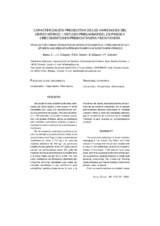Caracterización productiva de las variedades del cerdo ibérico. I: estudio preliminar de los pesos y crecimientos en premontanera y montanera
Productive characterisation in iberian pig varieties. I: preliminar study of grow and weight in premontanera and montanera periods
Autor
Sereno, José Robson Bezerra
Barba Capote, C.J.
Delgado-Bermejo, J.V.
Cañuelo, P.
Diéguez, E.
Editor
Universidad de Córdoba, Servicio de PublicacionesFecha
2000Materia
ConservaciónPreservación
METS:
Mostrar el registro METSPREMIS:
Mostrar el registro PREMISMetadatos
Mostrar el registro completo del ítemResumen
The productive behaviour of seven varieties belonging to the Iberian Pig Breed and three crosses F1 among them have been studied with a view of the preliminary productive characterisation of the breed. 1159 animals have been used, all of then castrated males with similar age. Six quantitative variables refereed to weight and growing concerning the prenatural feeding (premontanera) and natural feeding (montanera) periods were analysed. From our results we have concluded a mean weight of beginning of prenatural-feeding period near 53 kg, a mean weight of beginning of naturalfeeding period of 116 kg and a slaughter weight around 164 kg. The mean daily gain oscillated between 337 grams/day for the beginning of prenatural-feeding period and 586 for the beginning of natural-feeding period. The mean carcass yield was 83.37 p.100. We have to stand out the significative differences found among all the studies varieties for the studied variables, confirming the big genetic variability present in the breed and the existence of clear specialisation of the varieties. In the prenatural-feeding period the Lampiño variety stand out clearly of the other, while in the natural feeding period is the Torbiscal variety which shown the best behaviour. Se estudia el comportamiento de siete variedades del cerdo Ibérico y tres cruces F1 entre variedades con vistas a la caracterización productiva preliminar de la raza. Para ello se utilizaron 1159 animales, todos ellos machos castrados y de edades similares, donde se analizaron seis variables cuantitativas referidas a pesos y crecimientos en los periodos de premontanera y montanera. De los resultados obtenidos concluimos un peso de entrada a la premontanera medio en la raza próximo a los 53 kg, un peso a la entrada en montanera en torno a 116 kg y un peso de matanza alrededor de 164 kg. Las ganancias medias diarias oscilaron entre 337 g/día para el periodo de premontanera hasta 586 g/día de media en el periodo de montanera. El rendimiento a la canal medio fue del 83,37 p.100. Por otra parte, señalamos las diferencias altamente significativas entre las variedades para todas las variables estudiadas lo que confirma la gran variabilidad genética presente en la raza y la existencia de claras especializaciones productivas de las distintas variedades. En el periodo premontanera destaca claramente la variedad Lampiño frente al resto de variedades mientras que en el periodo de montanera es la variedad Torbiscal la que muestra un comportamiento superior.

